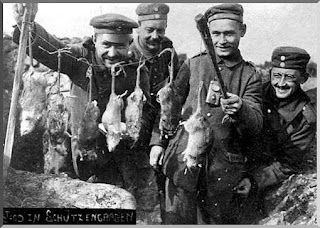During the First World War, trench life was something quite horrifying. Soldiers, especially those who were just young men, didn’t expect any of the horrors they encountered. The infestation of rats came in millions, invading the trenches and many soldiers saw first-hand, day after day, the rats chomping away on their dead comrades, firstly gauging out the dead mans’ eyes and liver.
 There were 2 types of rats, one which was black and the other brown; they were both feared greatly. The soldiers tried to get rid of them with clubbing, gunfire and even bayonet. However, all of this was in vain because no matter how many they accomplished in killing, one rat couple could produce over 900 offspring in one year alone.
There were 2 types of rats, one which was black and the other brown; they were both feared greatly. The soldiers tried to get rid of them with clubbing, gunfire and even bayonet. However, all of this was in vain because no matter how many they accomplished in killing, one rat couple could produce over 900 offspring in one year alone. Not only were the rats an enemy, the men also had to battle it out with lice, which were also the culprit for trench fever. Lice would breed in the seams of the soldiers’ clothing, making them itch unceasingly. Despite washing and delousing, many of the eggs were still hidden, and after a couple of hours with the generation of body heat, it would cause them to hatch once more. Trench fever was a very painful disease; it all started off with extreme pain and then followed by high fever, recovering could take up to 12 weeks. Trench life during World War I was not pleasant at all.


